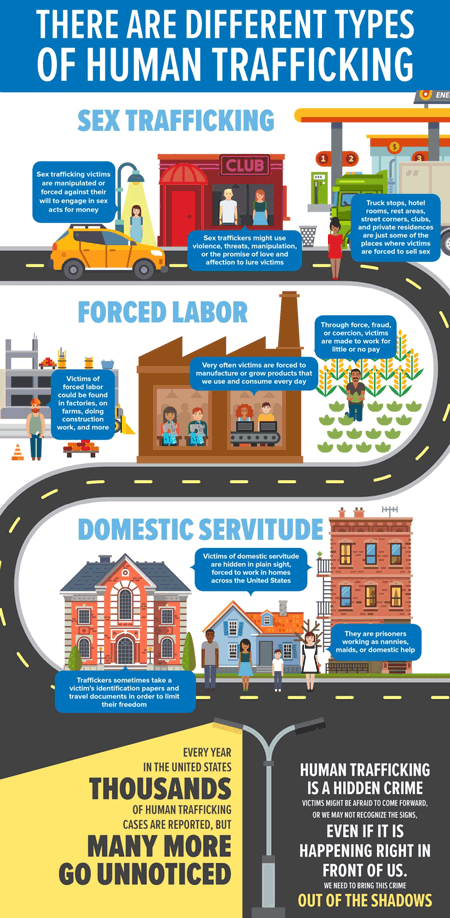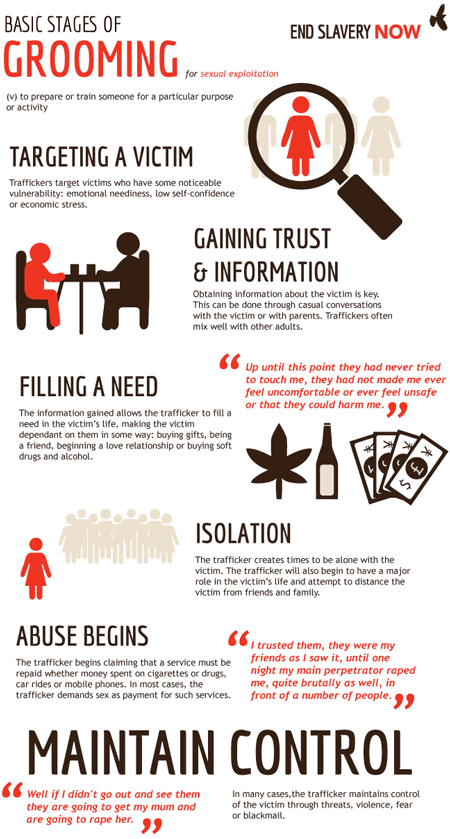From sex trafficking within escort services to labor trafficking of farmworkers, the ways humans are exploited differ greatly. Each type has unique strategies for recruiting and controlling victims and concealing the crime.
To eradicate human trafficking networks and help survivors, we must be able to identify and disrupt the manifestations of trafficking in our communities.
Polaris, 2017
From a global perspective there are two general categories of human trafficking: sex trafficking and labor trafficking. However, different entities may break these down with variations that reflect the complexity of the problem and differing experiences in specific areas.
In the United States the Department of Health and Human Services (HHS) Blue Campaign materials identify sex trafficking, forced labor, and domestic servitude as represented in the image below. Numbers for 2018 from the NHTH (Polaris Project) identify the top three types of trafficking cases as sex trafficking, labor trafficking, and sex-and-labor trafficking. Each of these categories is reflected in the kinds of businesses in which the trafficking takes place (NHTH, 2020).
In a recent report, the Polaris Project examined 32,000 documented human trafficking cases in the US from December 2007 to December 2016, and from this data identified 25 distinct business models for human trafficking.
Businesses That May Be Involved in Human Trafficking
- Escort Services
- Illicit Massage, Health, & Beauty
- Outdoor Solicitation
- Residential
- Domestic Work
- Bars, Strip Clubs, & Cantinas
- Pornography
- Traveling Sales Crews
- Restaurants & Food Service
- Peddling & Begging
- Agriculture & Animal Husbandry
- Personal Sexual Servitude
- Health & Beauty Services
- Construction
- Hotels & Hospitality
- Landscaping
- Illicit Activities
- Arts & Entertainment
- Commercial Cleaning Services
- Factories & Manufacturing
- Remote Interactive Sexual Acts
- Carnivals
- Forestry & Logging
- Health Care
- Recreational Facilities
Source: Polaris, 2017.
An important consideration here is that, while some of these business categories are clearly illegal, most also have entirely legitimate functions in our economy and the ability to spot possible indicators of human trafficking requires being observant, asking good questions, and being willing to "see" what might not seem obvious (Polaris, 2020).

Source: DHS, 2017.
Sex Trafficking
Sex trafficking is the crime of using force, fraud, or coercion to induce another individual to sell sex (Polaris, 2020b), and it is the most prevalent form of human trafficking in the United States. Sex trafficking is a high-profit and low-risk business where the commodity—the human being's body—can be sold repeatedly (Roe-Sepowitz et al., 2015). And, the highest profits per victim are in developed economies (Kelly, 2019). As noted earlier, common types of sex trafficking include escort services, pornography, illicit massage businesses, brothels, and outdoor solicitation (Polaris, 2020b).
Any child or teenager is at risk for any of these kinds of sex trafficking and if a victim is younger than 18 years of age then it does not matter if there is force, fraud, or coercion—simply inducing them to perform a commercial sex act is considered trafficking (USDOJ, 2017; NHTH, 2016a). The internet has fueled an explosion in child pornography and more of this form of sex trafficking (USDOJ, 2017a).
Recruiting and Grooming
Traffickers (abusers, pimps) recruit men, women, and children by identifying exploitable vulnerabilities.
Vulnerabilities class
- Lack of money
- Homelessness
- Substance abuse
- Severe loneliness
- Mental health challenges
Recruitment of child victims in the United States happens at malls, schools, bus and train stations, and group homes, among other locations—anywhere that children congregate. Traffickers are also recruiting through Facebook and other internet sites. Traffickers also use peers or classmates to befriend targets and slowly groom them to join the life (NCSSLE, 2020).
Grooming, a psychological and physical process aimed at transitioning a victim to a dependent role, is an integral part of the recruitment process. After targeting a potential victim, the abuser works to gain information about the victim and establish trust. Once the abuser discovers a need in the victim's life that they can fill—usually using manipulation, false promises, substance abuse, and violence—they have begun a process that leads to isolation of the victim and the beginning of abuse, often in the form of requirements for sex as payment for services. The abuser then maintains control of the victim, frequently by means of threats, violence, fear, or blackmail (Long, 2014).
Among pimps (someone who manages trafficking victims in order to commodify their bodies) a distinction is sometimes made between finesse pimps and guerilla pimps. Finesse pimping (more common with child victims) is accomplished by manipulative practices, aimed at convincing victims they love or care about them, but once seduced, control is maintained with physical and psychological torture. These tactics lead to a loss of autonomy for the victim and complete obedience to the pimp. Finesse pimps are skillful at identifying specific vulnerable children and exploiting their weaknesses, often using the "glamour" of the pimp/ho culture along with cultural acceptance of the demand for child victims as a means to maintain control (Williamson, 2015).
Guerilla pimps use violence and intimidation to manage victims and are more common among those trafficking adults.

Source: Long, 2014.
Labor Trafficking
Labor trafficking is another major type of human trafficking and may be divided into forced labor and domestic servitude (see image above). In the United States, the Trafficking Victims Protection Act of 2000 (TVPA) defines labor trafficking as "the recruitment, harboring, transportation, provision, or obtaining of a person for labor or services, through the use of force, fraud or coercion for the purpose of subjection to involuntary servitude, peonage, debt bondage or slavery."
Peonage is a status or condition of involuntary servitude based on real or alleged indebtedness. Debt bondage includes a pledge of services by a debtor (or someone under their control) to pay down known or unknown charges. The length and nature of the services are not limited or defined and the debtor is trapped in a cycle they can never escape (OTIP, 2017).
Labor trafficking includes people forced to work in homes as domestic servants, farmworkers coerced with violence while harvesting crops, or factory workers operating in inhumane conditions with little to no pay. A very large number of consumer and food products purchased in the United States are made with at least some elements of forced labor, and this includes items produced inside and outside the country (NHTH, 2020d).
Most female trafficking victims of labor exploitation are in domestic work and hospitality but most male victims are found in agriculture and construction. In manufacturing, the gender of victims is roughly equal (IOM, 2018).
Children are frequent victims of labor trafficking. They (and adults) are often threatened with exposure if they are not legal immigrants, or their passports and paperwork are held by their employer, or members of their family are threatened with injury or death. Labor trafficking does not seem to receive the attention that sex trafficking does in terms of investigation and exposure. This can happen for a variety of reasons including that, for minors, unlike with sex trafficking the use of force, fraud, or coercion is required to be present in order to move it from labor exploitation to labor trafficking (Miller, 2018).
Trafficking in Children
As noted above, children are frequent victims of both sex trafficking and labor trafficking, accounting for 21% of all identified victims (IOM, 2018). Almost half of identified cases of child trafficking begin with some family member involvement. Family involvement is up to four times higher with children than with adults, where about 9% of adult cases involve family members (IOM, 2017).
In human trafficking of children, the sources of recruitment are:
- Family / Relative 41%
- Intimate Partner 14%
- Friends 11%
- Other 34%
The main sectors of forced labor are:
- Begging 19%
- Domestic work 18%
- Hospitality 8%
- Illicit activities 6%
And the main methods of control are:
- Psychological 24%
- Physical 16%
- Sexual 10%
- Psychoactive substances 9%
About 71% of identified victims of human trafficking are women and 66% of child recruits are female, with 31% of children trafficked for forced labor and 58% for sexual exploitation (IOM, 2018, 2017).
About one-third of females are recruited by family members and over one-quarter by an intimate partner, while almost half of male victims are recruited by an acquaintance (IOM, 2018).
Back Next Page